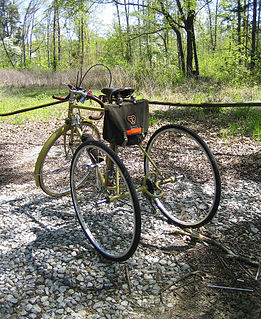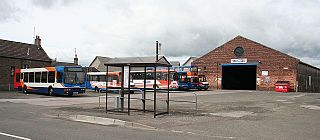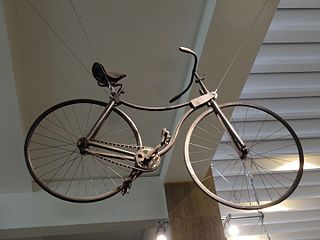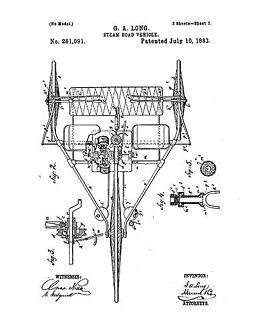
The Craigievar Express is a steam-powered tricycle built by Andrew 'Postie' Lawson between 1895 and 1897 in Craigievar, Scotland. [1] The vehicle's frame is made from wood, as are its wheels. [1] [2] The engine is a single-cylinder model and was purchased second hand from a sawmill. [1] The Express's boiler was obtained through Exchange and Mart . [1] The flywheel brake acted on the engine, and following the principles of the horse-carriage braking system (brake shoes attached to a lever) another was applied to the rims of the back wheels. [1]

Scotland is a country that is part of the United Kingdom. Sharing a border with England to the southeast, Scotland is otherwise surrounded by the Atlantic Ocean to the north and west, by the North Sea to the northeast and by the Irish Sea to the south. In addition to the mainland, situated on the northern third of the island of Great Britain, Scotland has over 790 islands, including the Northern Isles and the Hebrides.

Exchange and Mart is an online classified advertising website, owned by Newsquest Media Group. Exchange and Mart specialises in new and used motor vehicles, including commercial vehicles, motorcycles, caravans and motorhomes and caters for private sellers, as well as motor retailers. It was a printed publication from 1868 until 2009.

A flywheel is a mechanical device specifically designed to efficiently store rotational energy. Flywheels resist changes in rotational speed by their moment of inertia. The amount of energy stored in a flywheel is proportional to the square of its rotational speed. The way to change a flywheel's stored energy is by increasing or decreasing its rotational speed by applying a torque aligned with its axis of symmetry,
The Express steamed for the first time on 26 June 1897. [1] After that Lawson would drive it at local festivals. [3] He had ceased using the Express by 1934 and died in 1938. [3] [4]
The Craigievar Express was then sold to a man from Aberdeen before later being repurchased by Andrew Lawson's son James. [4] James carried out some restoration on the Express before transferring it to William Forbes-Sempill, 19th Lord Sempill. [4] The Express was then steamed at various events. [4] With Lord Sempill's death in 1965, his widow sold the vehicle to Maurice Smith, a Surrey-based car historian. [2] [5] [6] Smith carried out further restoration work and obtained a MOT certificate for the vehicle. [5] [6] In 1971 Maurice Smith completed the London to Brighton Veteran Car Run with the Craigievar Express. [7] [8]

William Francis Forbes-Sempill, 19th Lord Sempill AFC, AFRAeS, was a Scottish peer and record-breaking air pioneer who was later shown to have passed secret information to the Imperial Japanese military before the Second World War. Educated at Eton, he began his career as a pilot in the Royal Flying Corps and then served in the Royal Naval Air Service and Royal Air Force during the First World War. In 1921, Sempill led an official military mission to Japan that showcased the latest British aircraft. In subsequent years he continued to aid the Imperial Japanese Navy in developing its Navy Air Service.

The London to Brighton Veteran Car Run is the longest-running motoring event in the world. The first run was in 1896, and it has taken place most years since its initial revival in 1927. To qualify, the cars must have been built before 1905. It is also the world's largest gathering of veteran cars – 443 started in 2005, 484 in 2009, compared to 37 starters in 1927, 51 starters in 1930 and 131 in 1938.
In 1985 the Craigievar Express was purchased from Maurice Smith by the Grampian Transport Museum. [2] The money for the purchase came partly from donations from the general public but also grants from the Scottish Postal Board, the National Heritage Memorial Fund, the Royal Scottish museum and the National Fund for Acquisitions. [2] [9]

Grampian Transport Museum is a transport museum and charitable-based trust located in Alford, Aberdeenshire, Scotland. Follow the history of transport in the north east of Scotland through dramatic displays, working and climb aboard vehicle exhibits and video presentations.
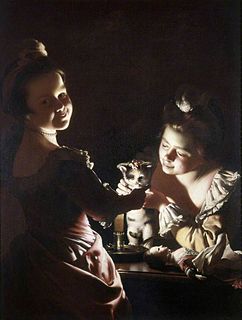
The National Heritage Memorial Fund (NHMF) was set up in 1980 to save the most outstanding parts of the British national heritage, in memory of those who have given their lives for the UK. It will receive £20 million Government grant in aid between 2011–15, allowing for an annual budget of between £4 million and £5 million.
The Craigievar Express is housed at the Grampian Transport Museum, where it is occasionally steamed. [8]


